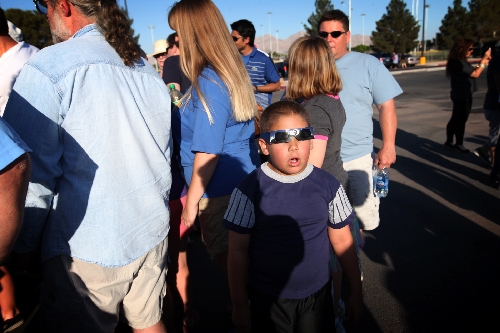Look, up in the sky! More celestial events coming
Get your funny glasses back out. Last month's solar eclipse wasn't the end of the celestial show.
An even more unusual - if less spectacular - event will take place Tuesday evening, when the planet Venus crosses the face of the sun.
The Transit of Venus, as it is known, happens twice every century or so. It last occurred in 2004 and won't happen again until the year 2117.
This time it will occur less than 48 hours after a partial lunar eclipse that also will be visible in Las Vegas, though just barely.
During Venus' hours-long journey across the bottom third of the sun's face, the unmagnified planet will appear (through protective lenses, of course) as a black dot about the size of the period at the end of this sentence.
"It's very rare, and it's important, at least historically," said Robert Pippin, who teaches astronomy and manages the planetarium at the College of Southern Nevada.
Pippin said the Transit of Venus in the 17th century set astronomers on the path to understanding the scale of the solar system.
The CSN planetarium and observatory, on the Cheyenne campus in North Las Vegas, will have specially filtered telescopes set up to view Tuesday's event when it starts at about 3 p.m.
Anyone else who wants to see it needs to use the same sort of protective eye wear used to view the May 20 annular eclipse of the sun. That means a pair of glasses specially made for such events or No. 14 welding goggles. Regular sunglasses won't cut it.
According to its website, the planetarium has safe solar glasses - ones that dim the intensity of the sun by 10,000 times - on sale for $2.50.
Former lieutenant governor, brain surgeon and still-practicing eccentric Lonnie Hammargren had about 5,000 pairs of shades specially made for the recent solar events, but he said he handed out almost all of them before last month's rare "ring of fire" eclipse.
No protective eye wear will be needed in the predawn hours of Monday morning, when the setting moon will pass through part of the Earth's shadow.
The partial lunar eclipse will last about two hours and peak at about 4 a.m.
Just don't get your hopes up too much, Pippin said. At best, the moon might take on a slightly reddish hue. He said most people probably won't even notice the difference, assuming they are up at that hour.
Contact reporter Henry Brean at hbrean@reviewjournal.com or 702-383-0350.


















